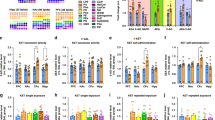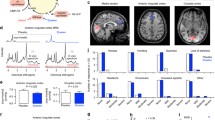Abstract
Observations that dopaminergic antagonists are beneficial in bipolar disorder and that dopaminergic agonists can produce mania suggest that bipolar disorder involves excessive dopaminergic transmission. Thus, mood stabilizers used to treat the disease might act in part by downregulating dopaminergic transmission. In agreement, we reported that dopamine D2-like receptor mediated signaling involving arachidonic acid (AA, 20:4n−6) was downregulated in rats chronically treated with lithium. To see whether chronic carbamazepine, another mood stabilizer, did this as well, we injected i.p. saline or the D2-like receptor agonist, quinpirole (1 mg/kg), into unanesthetized rats that had been pretreated for 30 days with i.p. carbamazepine (25 mg/kg/day) or vehicle, and used quantitative autoradiography to measure regional brain incorporation coefficients (k*) for AA, markers of signaling. We also measured brain prostaglandin E2 (PGE2), an AA metabolite. In vehicle-treated rats, quinpirole compared with saline significantly increased k* for AA in 35 of 82 brain regions examined, as well as brain PGE2 concentration. Affected regions belong to dopaminergic circuits and have high D2-like receptor densities. Chronic carbamazepine pretreatment prevented the quinpirole-induced increments in k* and in PGE2. These findings are consistent with the hypothesis that effective mood stabilizers generally downregulate brain AA signaling via D2-like receptors, and that this signaling is upregulated in bipolar disorder.


Similar content being viewed by others
Abbreviations
- AA:
-
Arachidonic acid
- PLA2 :
-
Phospholipase A2
- cPLA2 :
-
Cytosolic PLA2
- sn :
-
Stereospecifically numbered
- NMDA:
-
N-methyl-D-aspartate
- CBZ:
-
Carbamazepine
- PGE2 :
-
Prostaglandin E2
- TXB2 :
-
Thromboxane B2
- COX:
-
Cyclooxygenase
References
Anand A, Verhoeff P, Seneca N et al (2000) Brain SPECT imaging of amphetamine-induced dopamine release in euthymic bipolar disorder patients. Am J Psychiatry 157:1108–1114
Baf MH, Subhash MN, Lakshmana KM et al (1994) Alterations in monoamine levels in discrete regions of rat brain after chronic administration of carbamazepine. Neurochem Res 19:1139–1143
Barchas J, Hamblin M, Malenka R (1994) Biochemical hypotheses of mood and anxiety disorders. In: Siegel GJ, Agranoff BW, Albers RW, Molinoff PB (eds) Basic neurochemistry, 5th edn. Raven Press, New York, pp. 979–1001
Barros HM, Leite JR (1986) Effects of acute and chronic carbamazepine administration on apomorphine-elicited stereotypy. Eur J Pharmacol 123:345–349
Basselin M, Chang L, Bell JM et al (2005) Chronic lithium chloride administration to unanesthetized rats attenuates brain dopamine D2-like receptor-initiated signaling via arachidonic acid. Neuropsychopharmacology 30:1064–1075
Basselin M, Chang L, Bell JM et al (2006) Chronic lithium chloride administration attenuates brain NMDA receptor-initiated signaling via arachidonic acid in unanesthetized rats. Neuropsychopharmacology 31:1659–1674
Basselin M, Chang L, Chen M et al (2007) Chronic valproic acid reduces NMDA receptor-initiated signaling via arachidonic acid in rat brain (Abstract). J Neurochem 102(Suppl 1):146
Basselin M, Villacreses NE, Chen M et al (2007) Chronic carbamazepine administration reduces NMDA receptor-initiated signaling via arachidonic acid in rat brain. Biol Psychiatry 62:934–943
Basselin M, Villacreses NE, Langenbach R et al (2006) Resting and arecoline-stimulated brain metabolism and signaling involving arachidonic acid are altered in the cyclooxygenase-2 knockout mouse. J Neurochem 96:669–679
Basselin M, Villacreses NE, Lee HJ et al (2007) Flurbiprofen, a cyclooxygenase inhibitor, reduces the brain arachidonic acid signal in response to the cholinergic muscarinic agonist, arecoline, in awake rats. Neurochem Res 32:1857–1867
Bazinet RP, Rao JS, Chang L et al (2006) Chronic carbamazepine decreases the incorporation rate and turnover of arachidonic acid but not docosahexaenoic acid in brain phospholipids of the unanesthetized rat: relevance to bipolar disorder. Biol Psychiatry 59:401–407
Beaulieu JM, Sotnikova TD, Yao WD et al (2004) Lithium antagonizes dopamine-dependent behaviors mediated by an AKT/glycogen synthase kinase 3 signaling cascade. Proc Natl Acad Sci USA 101:5099–5104
Berk M, Dodd S, Kauer-Sant’anna M et al (2007) Dopamine dysregulation syndrome: implications for a dopamine hypothesis of bipolar disorder. Acta Psychiatr Scand (Suppl):41–49
Beutler AS, Li S, Nicol R et al (2005) Carbamazepine is an inhibitor of histone deacetylases. Life Sci 76:3107–3115
Bhattacharjee AK, Chang L, Lee HJ et al (2005) D2 but not D1 dopamine receptor stimulation augments brain signaling involving arachidonic acid in unanesthetized rats. Psychopharmacology (Berl) 180:735–742
Bhattacharjee AK, Chang L, White L et al (2006) D-amphetamine stimulates D2 dopamine receptor-mediated brain signaling involving arachidonic acid in unanesthetized rats. J Cereb Blood Flow Metab 26:1378–1388
Bhattacharjee AK, Chang L, White L et al Imaging apomorphine stimulation of brain arachidonic acid signaling via D2-like receptors in unanesthetized rats. Psychopharmacology (in press). doi: 10.1007/s00213-008-1073-3
Bialer M, Levy RH, Perucca E (1998) Does carbamazepine have a narrow therapeutic plasma concentration range? Ther Drug Monit 20:56–59
Chang MC, Grange E, Rabin O et al (1996) Lithium decreases turnover of arachidonate in several brain phospholipids. Neurosci Lett 220:171–174. Erratum in: Neurosci Lett 1997 31:222:141
Cipriani A, Rendell JM, Geddes JR (2006) Haloperidol alone or in combination for acute mania. Cochrane Database Syst Rev 3:CD004362
Cooper JR, Bloom FE, Roth RH (2003) The biochemical basis of neuropharmacology, 8th edn. Oxford University Press, Oxford
Cunningham MO, Jones RS (2000) The anticonvulsant, lamotrigine decreases spontaneous glutamate release but increases spontaneous GABA release in the rat entorhinal cortex in vitro. Neuropharmacology 39:2139–2146
Di Marzo V, Piomelli D (1992) Participation of prostaglandin E2 in dopamine D2 receptor-dependent potentiation of arachidonic acid release. J Neurochem 59:379–382
Ertley RN, Bazinet RP, Lee HJ et al (2007) Chronic treatment with mood stabilizers increases membrane GRK3 in rat frontal cortex. Biol Psychiatry 61:246–249
Esposito G, Giovacchini G, Der M et al (2006) Imaging signal transduction via arachidonic acid in the human brain during visual stimulation, by means of positron emission tomography. Neuroimage 34:1342–1351
Folch J, Lees M, Sloane Stanley GH (1957) A simple method for the isolation and purification of total lipides from animal tissues. J Biol Chem 226:497–509
Ghelardoni S, Tomita YA, Bell JM et al (2004) Chronic carbamazepine selectively downregulates cytosolic phospholipase A2 expression and cyclooxygenase activity in rat brain. Biol Psychiatry 56:248–254
Greenwood TA, Schork NJ, Eskin E et al (2006) Identification of additional variants within the human dopamine transporter gene provides further evidence for an association with bipolar disorder in two independent samples. Mol Psychiatry 11:125–133, 115
Hayakawa T, Chang MC, Rapoport SI et al (2001) Selective dopamine receptor stimulation differentially affects [3H]arachidonic acid incorporation, a surrogate marker for phospholipase A2-mediated neurotransmitter signal transduction, in a rodent model of Parkinson’s disease. J Pharmacol Exp Ther 296:1074–1084
Hosey LA, Thompson JL, Metman LV et al (2005) Temporal dynamics of cortical and subcortical responses to apomorphine in Parkinson disease: an H 152 O PET study. Clin Neuropharmacol 28:18–27
Ishikawa M, Mizukami K, Iwakiri M et al (2007) Immunohistochemical and immunoblot analysis of dopamine and cyclic AMP-regulated phosphoprotein, relative molecular mass 32,000 (DARPP-32) in the prefrontal cortex of subjects with schizophrenia and bipolar disorder. Prog Neuropsychopharmacol Biol Psychiatry 31:1177–1181
Jensen JB, Mork A (1997) Altered protein phosphorylation in the rat brain following chronic lithium and carbamezepine treatments. Eur Neuropsychopharmacol 7:173–179
Khan ZU, Gutierrez A, Martin R et al (1998) Differential regional and cellular distribution of dopamine D2-like receptors: an immunocytochemical study of subtype-specific antibodies in rat and human brain. J Comp Neurol 402:353–371
Kim KM, Valenzano KJ, Robinson SR et al (2001) Differential regulation of the dopamine D2 and D3 receptors by G protein-coupled receptor kinases and beta-arrestins. J Biol Chem 276:37409–37414
Lesch KP, Aulakh CS, Tolliver TJ et al (1991) Differential effects of long-term lithium and carbamazepine administration on Gs alpha and Gi alpha protein in rat brain. Eur J Pharmacol 207:355–359
Martucci L, Wong AH, De Luca V et al (2006) N-methyl-d-aspartate receptor NR2B subunit gene GRIN2B in schizophrenia and bipolar disorder: polymorphisms and mRNA levels. Schizophr Res 84:214–221
McCullumsmith RE, Kristiansen LV, Beneyto M et al (2007) Decreased NR1, NR2A, and SAP102 transcript expression in the hippocampus in bipolar disorder. Brain Res 1127:108–118
Montezinho LP, Castro MM, Duarte CB et al (2006) The interaction between dopamine D2-like and beta-adrenergic receptors in the prefrontal cortex is altered by mood-stabilizing agents. J Neurochem 96:1336–1348
Paxinos G, Watson C (1987) The rat brain in stereotaxic coordinates. Academic Press, New York
Peet M, Peters S (1995) Drug-induced mania. Drug Saf 12:146–153
Poddubiuk ZM, Blumberg JB, Kopin IJ (1982) Brain prostaglandin content in rats sacrificed by decapitation vs focused microwave irradiation. Experientia 38:987–988
Rao JS, Bazinet RP, Rapoport SI et al (2007) Chronic administration of carbamazepine downregulates AP-2 DNA binding activity and AP-2α protein expression in rat frontal cortex. Biol Psychiatry 61:154–161
Rao JS, Rapoport SI, Bosetti F (2005) Decrease in the AP-2 DNA-binding activity and in the protein expression of AP-2α and AP-2β in frontal cortex of rats treated with lithium for 6 weeks. Neuropsychopharmacology 30:2006–2013
Rapoport SI (2003) In vivo approaches to quantifying and imaging brain arachidonic and docosahexaenoic acid metabolism. J Pediatr 143:S26–S34
Rintala J, Seemann R, Chandrasekaran K et al (1999) 85 kDa cytosolic phospholipase A2 is a target for chronic lithium in rat brain. Neuroreport 10:3887–3890
Robinson PJ, Noronha J, DeGeorge JJ et al (1992) A quantitative method for measuring regional in vivo fatty-acid incorporation into and turnover within brain phospholipids: review and critical analysis. Brain Res Brain Res Rev 17:187–214
Seeman P, Van Tol HH (1994) Dopamine receptor pharmacology. Trends Pharmacol Sci 15:264–270
Shaldubina A, Einat H, Szechtman H et al (2002) Preliminary evaluation of oral anticonvulsant treatment in the quinpirole model of bipolar disorder. J Neural Transm 109:433–440
Shimizu T, Wolfe LS (1990) Arachidonic acid cascade and signal transduction. J Neurochem 55:1–15
Sokoloff P, Giros B, Martres MP et al (1990) Molecular cloning and characterization of a novel dopamine receptor D3 as a target for neuroleptics. Nature 347:146–151
Tabachnick BG, Fidell LS (2001) Computer-assisted research design and analysis. Allyn and Bacon ed., Boston
Tarazi FI, Baldessarini RJ (1999) Regional localization of dopamine and ionotropic glutamate receptor subtypes in striatolimbic brain regions. J Neurosci Res 55:401–410
Vial D, Piomelli D (1995) Dopamine D2 receptors potentiate arachidonate release via activation of cytosolic, arachidonic-specific phospholipase A2. J Neurochem 64:2765–2772
Wang X, Zhong P, Gu Z et al (2003) Regulation of NMDA receptors by dopamine D4 signaling in prefrontal cortex. J Neurosci 23:9852–9861
Wedzony K, Chocyk A, Mackowiak M et al (2000) Cortical localization of dopamine D4 receptors in the rat brain—immunocytochemical study. J Physiol Pharmacol 51:205–221
Whone AL, Watts RL, Stoessl AJ et al (2003) Slower progression of Parkinson’s disease with ropinirole versus levodopa: the REAL-PET study. Ann Neurol 54:93–101
Acknowledgments
This work was supported by the Intramural Research Program of the National Institute on Aging, National Institutes of Health. None of the authors has a financial or other conflict of interest related to this work.
Author information
Authors and Affiliations
Corresponding author
Rights and permissions
About this article
Cite this article
Basselin, M., Chang, L., Chen, M. et al. Chronic Carbamazepine Administration Attenuates Dopamine D2-like Receptor-Initiated Signaling via Arachidonic Acid in Rat Brain. Neurochem Res 33, 1373–1383 (2008). https://doi.org/10.1007/s11064-008-9595-y
Received:
Accepted:
Published:
Issue Date:
DOI: https://doi.org/10.1007/s11064-008-9595-y




